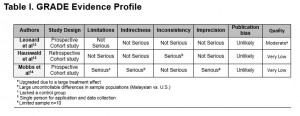Spinal Immobilization Adverse Effects vs. Benefits in the Trauma Patient
ABSTRACT
Background: Spinal Immobilization is a standard practice of preventing further injury to trauma patients with suspected severe spinal injuries. Clinical providers employ spinal immobilization devices as soon as traumatic spinal injuries are suspected. The use of spinal immobilization devices is not benign and can cause adverse complications for the patient to include restrictive breathing, obstructed airway, pain, or even death. This review assesses the current evidence of adverse effects from spinal immobilization in trauma patients.
Methods: An exhaustive search of available literature was conducted using the MEDLINE-Ovid, Web of Science, CINAHL, and Secondary References derived from articles found in the initial searches. Keywords searched included spinal immobilization, adverse, and trauma. The articles assessed trauma patients with possible spinal trauma that incurred adverse implications. The quality of relevant articles was evaluated using the GRADE Working Group guidelines.
Results: Three studies met eligibility criteria and were included in this systematic review. The studies consisted of a retrospective study and two prospective cohort studies. One study of 329 children found a statistically significant increase in pain score, rate of admission, and rate of radiological exam. The second study of 454 trauma patients reported little to no neurological effect of spinal immobilization on patients with spinal injuries. In the third study of 10 consecutive head-injured patients 90% had a rise in ICP following the application of a rigid cervical collar. All studies had a very low to moderate quality of evidence based on GRADE guidelines.
Conclusion: The effect of spinal immobilization that is associated with adverse complications such as respiratory compromise, pain, and increased mortality remains unclear. Large prospective studies are needed to evaluate the necessity of spinal immobilization. Randomized controlled trials are required in order to establish an evidence based approach to spinal injuries in trauma patients.
Keywords: Trauma, spinal immobilization, adverse effects

(Click on image to enlarge.)
REVIEWED STUDIES:
Hauswald M, Ong G, Tandberg D, Omar Z. Out-of-hospital spinal immobilization: its effect on neurologic injury. Acad Emerg Med. 1998;5:214-219.
Leonard JC, Mao J, Jaffe DM. Potential Adverse Effects of Spinal Immobilization in Children. Prehospital Emergency Care. 2012;16:513-518.
Mobbs RJ, Stoodley MA, Fuller J. Effect of cervical hard collar on intracranial pressure after head injury.
AUTHOR: Michael Duncan is currently completing his second year in the School of PA Studies at Pacific University, Oregon. He will graduate with an MS degree in August, 2016.
